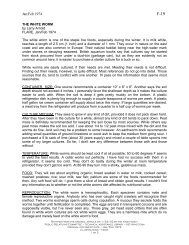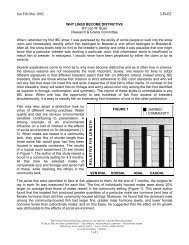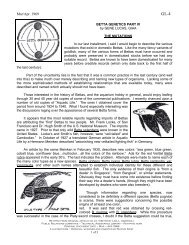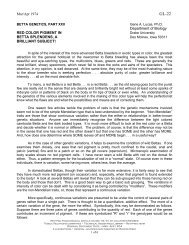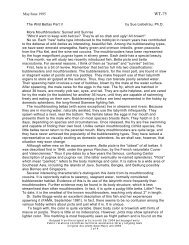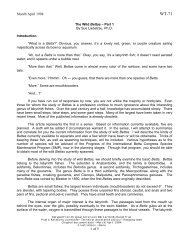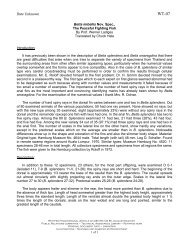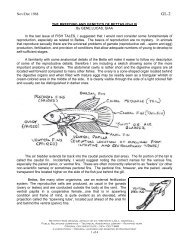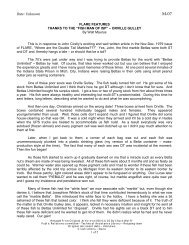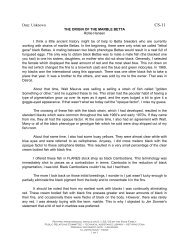Culling Your Betta Spawns
Culling Your Betta Spawns
Culling Your Betta Spawns
- No tags were found...
You also want an ePaper? Increase the reach of your titles
YUMPU automatically turns print PDFs into web optimized ePapers that Google loves.
Sept/Oct 1987SA5-4CULLING YOUR BETTA SPAWNSPARRIS JONESNow that your betta fry are at least 6 weeks old, you can start culling or separatingthe undesirable fry. As I mentioned in the previous article, this phase is possiblygruesome, but a very necessary step. The phase, for me, is one of the hardest todescribe, since culling is very subjective.I feel the act of culling your spawn is one of the most demanding on the hobbyist. Theact requires the hobbyist to have the discipline to only keep the best from a spawn and to havethe patience to always strive to improve his line. Regardless of how show quality your line maybe, there is always something you can improve. This act is especially hard on the new hobbyist,since they are still happy over just getting their bettas to spawn and now they must get rid ofhalf, if not more, of their spawn.Because of the demand culling requires I only review my fish for 10-15 minutes at atime. This means I'm continually reviewing a spawn from the time they are 6-8 weeks old. I findthe ideal time for me to cull is when I'm doing water changes.While the fry are still in tanks the following are criteria I use to cull fry:- swim bladder problems- body deformities (crooked spine, sway back bodies)- missing fins- undesirable colorsWhen I have a spawn with a few fry showing swim bladder problems, these fry areshowing a weakness which I don't want to possibly pass on to the next generation. Therefore,they are eliminated. Swim bladder may not be hereditary but why take a chance.I did not mention size variation as criteria since I have found in some lines your best frymay be the late developers. For a line you are just starting to work with, you may want to findout whether the earlier or later developers are the best. Of course you will normally find a fewfry, which never start growing and these should be eliminated.When jarred I continue to cull, using the following to eliminate undesirable fry:- fin pinholes- body deformities (crooked spine, sway back bodies)- crooked or bent rays in fins- undesirable colorsYou may have noticed that I have now included pinholes in fins and torn fins. I don'tkeep my bettas isolated from one another by using cardboard or other materials. Rather theynormally are flaring off and on. Right or wrong, I feel, if several males are next to one anotherand one gets a split fin, this shows a weakness in the fin development. Therefore, he iseliminated. Also, if I use the same care with all my bettas and one gets a pinhole in his fins, Ibelieve this shows again a weakness in fin development. Once again, that betta is eliminated.I'm always concerned about the fin development of my bettas. I continue to cull for theslightest finnage problems until they are fully mature. I have seen instances where bettasshowing good caudal development at a young age, when matured have a spade shape caudalfin. In addition, other young bettas showing full dorsals when older have bent rays in theirdorsals.Retyped from the original article on 6/26/2004 by the page familyPublic relations committee- technical assistance library retyping teamOriginal document date- Sept/Oct 1987 FLARE1 of 2
Sept/Oct 1987SA5-4Of course, waiting until bettas are almost fully mature before using them to spawnmeans I don't spawn them as soon as possible. But I'd rather wait a little longer to insure notpassing any undesirable traits to future generations.Besides being critical on fin development the other item I really become critical about iscolor variation. In blues, I continue to check for red wash in the anal and pectoral fins. Someblues at a younger age show no red wash in their anal fins, but when older show considerablered wash.I feel recording the reason(s) why most fish are eliminated in a spawn is just asimportant as the act of culling. I keep a log of each spawn, which contains the following items:- the spawn, where the male and female came from- the color, age, and fin development of both parents- the date of the spawn- the expected results of the spawn- the date when they started being jarred- the date when they started having full fin development- the dominant reason(s) why some were culled from the spawn.In setting up subsequent spawns I try not to propagate problems which I culled from thecurrent generation. For example, if I had a blue spawn which showed a lot of red wash I wouldnot use bettas from that spawn with parents from another spawn with the same problem. Eventhough the parents may not show red wash, their brothers and/or sisters did have that problem.After culling your betta spawns you will probably be left with 12 or less choice bettas.Next issue, I will discuss showing your bettas. Until then ... BETTER BETTAS.Retyped from the original article on 6/26/2004 by the page familyPublic relations committee- technical assistance library retyping teamOriginal document date- Sept/Oct 1987 FLARE2 of 2



